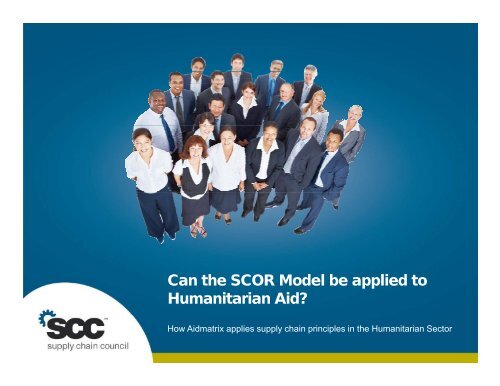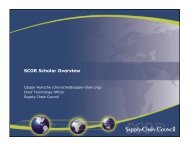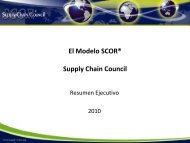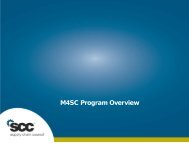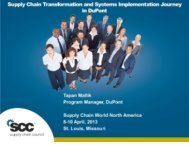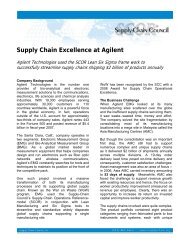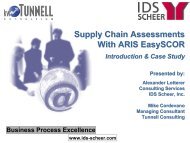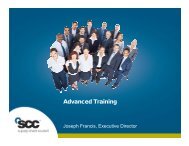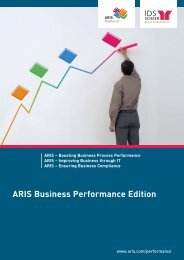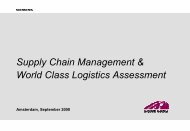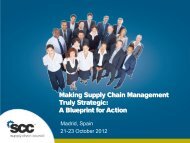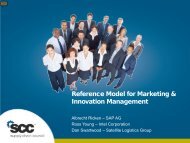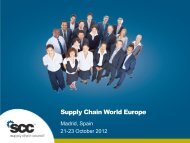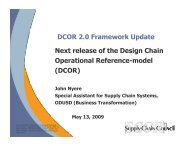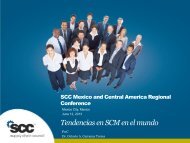Can the SCOR Model be applied to Humanitarian Aid?
Can the SCOR Model be applied to Humanitarian Aid?
Can the SCOR Model be applied to Humanitarian Aid?
You also want an ePaper? Increase the reach of your titles
YUMPU automatically turns print PDFs into web optimized ePapers that Google loves.
<strong>Can</strong> <strong>the</strong> <strong>SCOR</strong> <strong>Model</strong> <strong>be</strong> <strong>applied</strong> <strong>to</strong><br />
<strong>Humanitarian</strong> <strong>Aid</strong>?<br />
How <strong>Aid</strong>matrix applies supply chain principles in <strong>the</strong> <strong>Humanitarian</strong> Sec<strong>to</strong>r<br />
© 2010 Supply Chain Council. ALL RIGHTS RESERVED. | Slide 1 | 19 Oc<strong>to</strong><strong>be</strong>r 2010
Agenda<br />
• <strong>Aid</strong>matrix Overview<br />
• Case Studies<br />
› Haiti Earthquake<br />
› United Kingdom Hunger Relief<br />
• <strong>SCOR</strong> <strong>Model</strong> for <strong>Humanitarian</strong> <strong>Aid</strong><br />
• CSR and Supply Chains<br />
• Conclusion<br />
© 2010 Supply Chain Council. ALL RIGHTS RESERVED. | Slide 2 | 19 Oc<strong>to</strong><strong>be</strong>r 2010
About The <strong>Aid</strong>matrix Foundation<br />
Offices: USA, Germany, India<br />
<strong>Aid</strong>matrix is an international nonprofit sponsored<br />
by some of <strong>the</strong> world’s leading corporations<br />
We leverage innovative solutions from industry<br />
and <strong>to</strong> serve our partners in Nonprofit world<br />
We promote: <strong>the</strong> Right <strong>Aid</strong> <strong>to</strong> <strong>the</strong> Right People at<br />
<strong>the</strong> Right Time<br />
<strong>Aid</strong>matrix affects more than 65 million people<br />
and 35,000 nonprofits<br />
We orchestrate more than $1.5 Billion in <strong>Aid</strong> each<br />
year<br />
© 2010 Supply Chain Council. ALL RIGHTS RESERVED. | Slide 3 | 19 Oc<strong>to</strong><strong>be</strong>r 2010
The Challenges:<br />
Traditional <strong>Humanitarian</strong> <strong>Aid</strong> Processing<br />
Donors/ Suppliers Lead Relief Agencies/HQ’s Field Relief Agencies Field Agents<br />
Inefficiencies:<br />
Multiple phone<br />
calls and faxing<br />
Manual Reporting<br />
Data re-entry<br />
Duplication of effort<br />
Data errors<br />
Downtime<br />
& Wait-time<br />
No Visibility<br />
© 2010 Supply Chain Council. ALL RIGHTS RESERVED. | Slide 4 | 19 Oc<strong>to</strong><strong>be</strong>r 2010<br />
X
<strong>Humanitarian</strong> <strong>Aid</strong>: The Next Generation<br />
Donors/Suppliers<br />
NGOs<br />
Field Relief<br />
Agencies/Locations<br />
Donations Management<br />
<strong>Aid</strong> Allocation<br />
Field Agent<br />
Technology Enablement<br />
A<br />
© 2010 Supply Chain Council. ALL RIGHTS RESERVED. | Slide 5 | 19 Oc<strong>to</strong><strong>be</strong>r 2010
The <strong>Aid</strong>matrix Network<br />
Enabling over 35,000 Relief Agencies/Partners<br />
• International NGO’s<br />
• Local NGO’s<br />
• Governments<br />
› National, Local, NATO, etc.<br />
• Corporations/Associations<br />
© 2010 Supply Chain Council. ALL RIGHTS RESERVED. | Slide 6 | 19 Oc<strong>to</strong><strong>be</strong>r 2010
Our Impact<br />
Enabling Leaders in <strong>Humanitarian</strong> <strong>Aid</strong><br />
• Hunger Relief<br />
• Medical Relief<br />
• Disaster Relief<br />
• General <strong>Humanitarian</strong> <strong>Aid</strong><br />
© 2010 Supply Chain Council. ALL RIGHTS RESERVED. | Slide 7 | 19 Oc<strong>to</strong><strong>be</strong>r 2010
Nodes Connected on The <strong>Aid</strong>matrix<br />
Network<br />
• Sharing Needs and Donation Offers<br />
› WithinaNetwork<br />
› With o<strong>the</strong>r<br />
organizations,<br />
governments,<br />
Associations<br />
(optional)<br />
= <strong>Aid</strong>matrix<br />
Network (example)<br />
= O<strong>the</strong>r <strong>Aid</strong>matrix<br />
Network Nodes<br />
© 2010 Supply Chain Council. ALL RIGHTS RESERVED. | Slide 8 | 19 Oc<strong>to</strong><strong>be</strong>r 2010
Case Studies – Haiti Earthquake<br />
• Supply Chain issues following a disaster<br />
• Difficult <strong>to</strong> plan natural disasters and impact<br />
© 2010 Supply Chain Council. ALL RIGHTS RESERVED. | Slide 9 | 19 Oc<strong>to</strong><strong>be</strong>r 2010
Haiti – What was Needed - Examples<br />
• Each disaster has unique requirements<br />
• First Responder<br />
› Search dogs<br />
› Medical supplies<br />
› Water and Food<br />
› Shelter<br />
• Rebuilding/Development<br />
› Construction<br />
› Communication<br />
© 2010 Supply Chain Council. ALL RIGHTS RESERVED. | Slide 10 | 19 Oc<strong>to</strong><strong>be</strong>r 2010
Haiti – How <strong>to</strong> Transport<br />
• Airport in Port au Prince destroyed<br />
• Port destroyed<br />
d<br />
• Roads destroyed<br />
• Trucks destroyed<br />
• Government shutdown<br />
• Cus<strong>to</strong>ms shutdown<br />
• Impact of transportation problems<br />
› Food rotted while waiting <strong>to</strong> <strong>be</strong> distributed<br />
› Medical supplies could not get through cus<strong>to</strong>ms<br />
© 2010 Supply Chain Council. ALL RIGHTS RESERVED. | Slide 11 | 19 Oc<strong>to</strong><strong>be</strong>r 2010
Haiti – Where <strong>to</strong> Warehouse<br />
• Warehouses and buildings destroyed<br />
• New NGOs setting up<br />
• In-kind donations arrived<br />
• Temporary areas set up<br />
• Problems with <strong>the</strong>ft<br />
• Lack of electricity<br />
• Lack of internet connections<br />
© 2010 Supply Chain Council. ALL RIGHTS RESERVED. | Slide 12 | 19 Oc<strong>to</strong><strong>be</strong>r 2010
Haiti – How <strong>to</strong> Support Relief Workers<br />
• Need people – employees and volunteers<br />
• Need <strong>to</strong> provide shelter, food and water<br />
© 2010 Supply Chain Council. ALL RIGHTS RESERVED. | Slide 13 | 19 Oc<strong>to</strong><strong>be</strong>r 2010
Haiti – Lessons Learned from<br />
<strong>Humanitarian</strong> Logistics Association (HLA)<br />
• Good logistician can still have difficulties in<br />
emergency settings<br />
• Need rest <strong>to</strong> help reduce stress and burnout<br />
• Security and safety! Do not ignore!<br />
• Do not take fuel availability for granted<br />
• Take communication challenges in<strong>to</strong> account<br />
• We were all reminded on how violent food<br />
distributions can turn<br />
• VIP Visits – good for moral but do not come and<br />
shut aid influx by closing airspace – doesn’t help<br />
saving lives<br />
© 2010 Supply Chain Council. ALL RIGHTS RESERVED. | Slide 14 | 19 Oc<strong>to</strong><strong>be</strong>r 2010
Haiti – Lessons Learned from<br />
<strong>Humanitarian</strong> Logistics Association (HLA)<br />
We sometimes make it hard<br />
• Did we give correct info <strong>to</strong> shippers on <strong>the</strong> most<br />
optimal way <strong>to</strong> receive cargo?<br />
• Did we minimize handling, optimize deliveries?<br />
• Did we share pipelines with cluster <strong>to</strong> make sure<br />
<strong>the</strong>y are aware of incoming cargo and did we<br />
give <strong>the</strong>m <strong>the</strong> justification for funding that <strong>the</strong>y<br />
are seeking from donors?<br />
© 2010 Supply Chain Council. ALL RIGHTS RESERVED. | Slide 15 | 19 Oc<strong>to</strong><strong>be</strong>r 2010
<strong>Aid</strong>matrix Making a Difference in Haiti<br />
January 12, 2010 Earthquake<br />
• U.S. Donations Management Portal<br />
for Relief Efforts<br />
› Over $300 Million in product offered<br />
› 120+ Recipient NGOs<br />
› Over 200 offers matched<br />
› Nearly 300 needs entered by NGOs<br />
• Over $100,000 raised in week following<br />
disaster, estimated $3 Million referred <strong>to</strong><br />
Clin<strong>to</strong>n-Bush Haiti Fund<br />
• <strong>Aid</strong>matrix Staff<br />
emergency deployed <strong>to</strong><br />
Port Au Prince <strong>to</strong><br />
set up online<br />
relief warehouses<br />
for NGO partners<br />
© 2010 Supply Chain Council. ALL RIGHTS RESERVED. | Slide 16 | 19 Oc<strong>to</strong><strong>be</strong>r 2010<br />
16<br />
X
Case Studies – FareShare<br />
UK Food Bank Network<br />
© 2010 Supply Chain Council. ALL RIGHTS RESERVED. | Slide 17 | 19 Oc<strong>to</strong><strong>be</strong>r 2010
FareShare – Supply Chain<br />
They source food...<br />
...in<strong>to</strong> <strong>the</strong>ir network...<br />
...distribute it <strong>to</strong><br />
charities and<br />
community<br />
organisations...<br />
...and get food <strong>to</strong><br />
people that need it.<br />
2,800 <strong>to</strong>nnes of food<br />
from <strong>the</strong> industry<br />
11 FareShare<br />
Depots<br />
600 organisations 6.7m meals<br />
© 2010 Supply Chain Council. ALL RIGHTS RESERVED. | Slide 18 | 19 Oc<strong>to</strong><strong>be</strong>r 2010
FareShare – The Scale of <strong>the</strong> Challenge<br />
WRAP data (1) has confirmed:<br />
• 362,000 <strong>to</strong>nnes of food waste in retail<br />
• 4,000 <strong>to</strong>nnes in distribution<br />
• 2,591,000 <strong>to</strong>nnes in manufacturing<br />
Whilst at <strong>the</strong> same time:<br />
• 13.2 million people live in relative poverty (2)<br />
• 7 million are effected by low income (3)<br />
• 4 million are classed as living in food poverty (4)<br />
Food Surplus<br />
Food Poverty<br />
(1)<br />
“Waste arisings in <strong>the</strong> supply of food and drink <strong>to</strong> households in <strong>the</strong> UK”, WRAP, 2010<br />
(2)<br />
“A minimum income for healthy living”, Journal of epidemiology and Community Health, 2007<br />
(3) Moni<strong>to</strong>ring i Poverty and dSocial Exclusion, Joseph Rowntree Foundation, 2007<br />
(4)<br />
Poverty and Social Exclusion in Britain, Joseph Rowntree Foundation, 2000<br />
© 2010 Supply Chain Council. ALL RIGHTS RESERVED. | Slide 19 | 19 Oc<strong>to</strong><strong>be</strong>r 2010
FareShare – Interaction with Suppliers<br />
Delivery in high 90%s<br />
Fit for consumption<br />
surplus <strong>to</strong> FareShare<br />
High volume<br />
manufacturing –<br />
800,000,000<br />
litres/year<br />
Waste <strong>to</strong> AD<br />
(Anaerobic Digestion)<br />
Last year Ger<strong>be</strong>r had surplus of only 0.04% -<br />
but this meant 300,000 litres <strong>to</strong> FareShare – 1.2 million servings<br />
© 2010 Supply Chain Council. ALL RIGHTS RESERVED. | Slide 20 | 19 Oc<strong>to</strong><strong>be</strong>r 2010
FareShare – Expansion Plans and<br />
On Line Management System<br />
2009:<br />
2,800 <strong>to</strong>nnes of food 11 FareShare<br />
600 organisations 6.7m meals<br />
from <strong>the</strong> industry<br />
Depots<br />
2018:<br />
20,500 <strong>to</strong>nnes of food<br />
from <strong>the</strong> industry<br />
22 FareShare<br />
Depots<br />
2,200 organisations 49m meals<br />
“Our current collaboration with <strong>Aid</strong>matrix is at a pivotal point in our<br />
development. ”<br />
“The OMS will produce hard <strong>be</strong>nefits in<br />
terms of more efficient throughput but<br />
has also had spin off <strong>be</strong>nefits such as<br />
allowing us <strong>to</strong> revisit and refine our<br />
business processes, and improve our<br />
data integrity. ”<br />
David Meller, Operations Manager<br />
© 2010 Supply Chain Council. ALL RIGHTS RESERVED. | Slide 21 | 19 Oc<strong>to</strong><strong>be</strong>r 2010
What’s special<br />
A magical transformation…<br />
We win - society wins - <strong>the</strong> environment wins - our partners win<br />
... and <strong>the</strong> more we do <strong>the</strong> bigger <strong>the</strong> gains.<br />
© 2010 Supply Chain Council. ALL RIGHTS RESERVED. | Slide 22 | 19 Oc<strong>to</strong><strong>be</strong>r 2010
<strong>SCOR</strong> <strong>Model</strong> for <strong>Humanitarian</strong> <strong>Aid</strong><br />
• Similarities <strong>to</strong> Commercial Sec<strong>to</strong>r<br />
› Core model - Plan, Source, Make, Delivery and Return –<br />
all apply <strong>to</strong> <strong>the</strong> supply chain process<br />
› On-going aid is similar <strong>to</strong> commodity products<br />
› Disaster aid is similar il <strong>to</strong> make <strong>to</strong> order products<br />
• Differences <strong>to</strong> Commercial Sec<strong>to</strong>r<br />
› Business model – impact lives ra<strong>the</strong>r than make money<br />
› Funding comes mainly from donors – little selling<br />
› Supplies can come from donors – some unsolicited<br />
› Little manufacturing but some kitting<br />
› Delivery can go directly <strong>to</strong> person in need<br />
› Donor transparency requirements<br />
© 2010 Supply Chain Council. ALL RIGHTS RESERVED. | Slide 23 | 19 Oc<strong>to</strong><strong>be</strong>r 2010
CSR and Supply Chains<br />
• Many corporations embracing corporate social responsibility<br />
(CSR) as part of <strong>the</strong>ir core values<br />
• Excess usable inven<strong>to</strong>ry is an opportunity <strong>to</strong> provide<br />
humanitarian aid<br />
• However excess unusable inven<strong>to</strong>ry can cause problems<br />
for humanitarian workers<br />
• Good inven<strong>to</strong>ry donated <strong>to</strong> <strong>the</strong> right organization is a win-win<br />
› Corporation: Tax write-offs, reduced disposal fees, corporate social<br />
responsibility, positive press<br />
› NGOs: Low cost inven<strong>to</strong>ry for humanitarian aid<br />
• Need for new processes in <strong>the</strong> supply chain <strong>to</strong> identify<br />
excess donate-able inven<strong>to</strong>ry<br />
© 2010 Supply Chain Council. ALL RIGHTS RESERVED. | Slide 24 | 19 Oc<strong>to</strong><strong>be</strong>r 2010
Conclusion<br />
• <strong>Humanitarian</strong> aid is a complex supply chain<br />
• <strong>Aid</strong> agencies are <strong>be</strong>hind <strong>the</strong> commercial sec<strong>to</strong>r in<br />
embracing supply chain principles<br />
• Commercial sec<strong>to</strong>r can add a new dimension <strong>to</strong> <strong>the</strong>ir<br />
supply chain by incorporating opportunities for<br />
donating products - for corporate social responsibility<br />
as well as good business practice<br />
• <strong>SCOR</strong> model should incorporate humanitarian aid<br />
• Supply Chain Counsel should target NGO mem<strong>be</strong>rs<br />
© 2010 Supply Chain Council. ALL RIGHTS RESERVED. | Slide 25 | 19 Oc<strong>to</strong><strong>be</strong>r 2010
Contact Information<br />
www.aidmatrix.org<br />
Shari Temple<br />
The <strong>Aid</strong>matrix Foundation<br />
Managing g Direc<strong>to</strong>r - EMEA<br />
+49 8161 935654<br />
Shari_Temple@aidmatrixeurope.org<br />
© 2010 Supply Chain Council. ALL RIGHTS RESERVED. | Slide 26 | 19 Oc<strong>to</strong><strong>be</strong>r 2010


